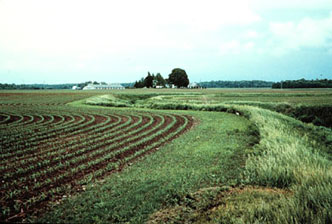New strategies protect farmland, improve ecology
By Bill Brown
Farms.com
Scientists looking for best practices to prevent runoff are recommending farmers maintain buffers between crops and trees, rather than planting close to tree lines.
The most recent study from the University of Missouri looked at a variety of methods to prevent runoff, such as different combinations of crops, trees, and buffer zones. Researchers found the most effective tactic was to create buffer zones that reflected the size of the trees.
For example, for 20-feet-tall trees, they recommend a buffer of at least six to nine feet.
A buffer zone would be vegetation cover such as native grasses, wildlife plantings, trees, filter strips, or riparian buffers. (The latter is a type of buffer strip beside a stream.)

Trees alone can prevent runoff, but they can also negatively affect yields.
“We found tree buffers along streams and waterways hurt crop growth in two ways,” reported lead researcher Ranjith Udawatta.
“The shade from tall trees prevents sunlight from reaching the crops, and the trees win the competition for water, as their roots reach much wider and deeper. Cutting the tree roots alone doesn’t work, as the shade from the trees still reduces crop yields adjacent to the trees.”
Researchers also found that soybeans were evidently unaffected by proximity to trees.
Preventing runoff of soil and water is important to protect farmland and downstream ecology and water quality.
The study, "Yield Differences Influenced by Distance from Riparian Buffers and Conservation Reserve Program," was coauthored by Clark Gantzer, Tim Reinbott, Ray Wright, and Robert Pierce II and was published in Agronomy Journal in 2016.